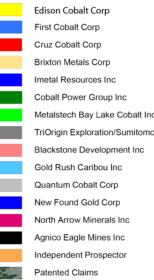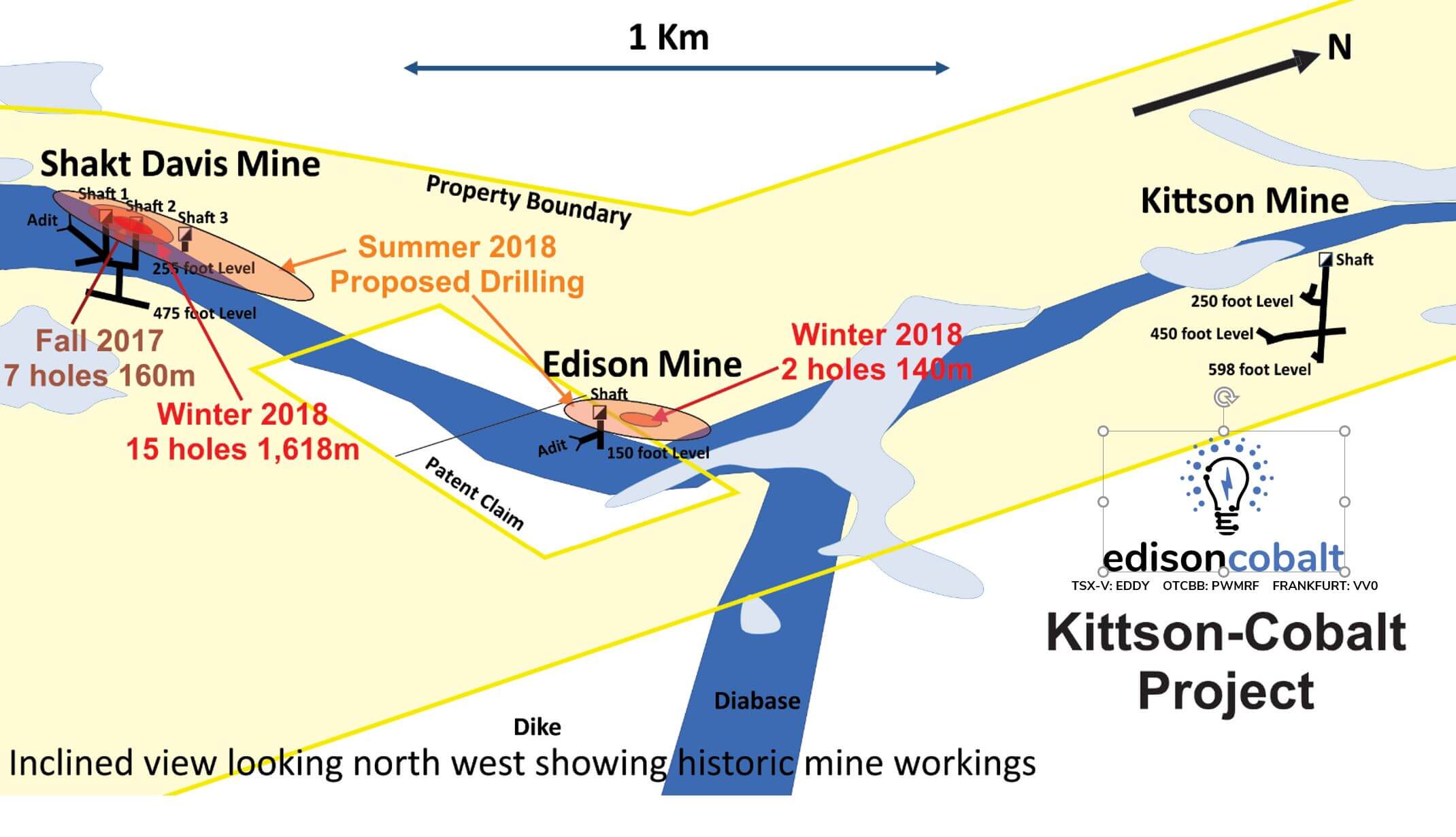Cobalt Property
LOCATED WITHIN THE PROLIFIC COBALT MINING CAMP
The Project is located near the town of Cobalt in northeast Ontario, Canada. The Project hosts the historic Thomas Edison, Shakt-Davis and Cobalt-Kittson mines, as well as numerous historic workings, the deepest extending down to 628 feet, and over 2,500 feet of lateral workings. Cobalt mineralization occurs in Proterozoic-aged quartz-carbonate veins hosted in brittle shears in Nipissing diabase. This style of mineralization is similar to that of the famous Cobalt Silver Camp Located ~15 km east of the Property, which produced 420 million ounces of silver with cobalt as a significant by-product. Veins hosting the mineralization at the Kittson-Cobalt Project differ from the typical Cobalt Silver Camp veins in that they are lower in silver but richer in cobalt, and are associated with significant gold. Historic reports from the Shakt-Davis mine indicate values of 1.5% Co over 1.37 metres and select grab samples returning up to 4% Co and 93.3 g/t Au. Locally significant nickel, copper and to a lesser extend lead, zinc and bismuth also occur within the quartz-carbonate veins.
THREE PAST PRODUCING MINES ON THE PROPERTY
The Shakt Davies mine saw intermittent development from 1906 – 1964, with the bulk of the underground working completed between 1924 – 1926. No production records remain, however historic reports indicate values of 1.5% cobalt over 1.37 meters and select grab samples returning up to 4% cobalt and 93.3 g/t gold. More recent sampling (1987) of the mine waste pile by the Ontario Geological Survey personnel returned 0.25% cobalt, 0.75 % nickel, 0.05% copper and 3.4 g/t gold.
THE EDISON MINE
The Thomas Edison mine, as the name implies, was developed by the famous inventor and entrepreneur Thomas Edison. While Edison is better known for inventions such as the first practical light bulb, he was also very involved in the mining industry. Edison pioneered new geophysical techniques, mineral extraction technologies, and developed the battery powered miners’ head lamp. He was instrumental in the discovery of nickel at Falconbridge, Ontario and also had interests in iron ore in New Jersey, and gold in New Mexico. Edison was heavily involved with the original Cobalt, Ontario silver rush, however it was not the silver he was after. At the turn of the 20th century, Edison was developing a new cobalt-Iron battery (US patent No. US678722A). Similar to today, Edison had difficulty sourcing sufficient supplies of cobalt. In order to keep the price down, Edison sent undercover representatives to Cobalt, Ontario to buy cobalt bearing minerals, which were produced as a by-products from silver mining in the area, for his battery manufacturing facility in New Jersey. He also used these representatives to attempt to buy high-grade cobalt silver mines and prospects. Eventually Edison acquired the Darby property (now the Thomas Edison Mine) in 1905. From 1905 to 1907 Edison remotely directed operations at the mine which included sinking two shafts to 150 feet, which were connected by an adit, as well as several exploration drifts and crosscuts. Between 6 and 8 tons of ore of unknown grade are reported to have been extracted, but no commercial production is recorded. Edison’s correspondence with his agent in Cobalt who was later his mine manager has been preserved and makes for a fascinating read. It has been well summarized in “TIMES WERE HARD BUT MEMORIES ARE GOOD” Proceeding of the history workshop, Timiskaming Abitibi Heritage Association, April 27, 1996, which is available from Rosanne Fisher Publishing in Haileybury, Ontario.
SHAKT-DAVIS MINE
At the Shakt-Davis mine several major calcite veins are hosted in a fractured and faulted zone within Nipissing diabase. This zone strikes northeast (~60°) parallel to a ~120 m thick vertical diabase dyke. The main vein varies from 1 to 7 m, whereas the vertically oriented chimney vein ranges from 1 to 3 m wide. Both are vertically oriented and contain smaltite (Co), cobaltite (Co), gersdorffite (Co), erythrite (Co), annabergite (Ni), pyrite, chalcopyrite (Cu), and niccolite (Ni). From assessment files in the Cobalt MNDM office, “Assays and analyses indicated 1.5% Co and minor Ag over a width of 1.37 m with select grab samples indicating up to 4% Co, and others with up to 2.72 oz/t Au. A further test of hand-picked ore indicated values of 0.87 oz/t Au, 0.25 oz/t Ag, 7.92% Co, and 7.72% Ni. Another smaltite ore sample returned 97 oz/ton Ag, 0.336% Co, and 0.18% Ni (Born and Hitch, 1990) Grab samples collected by N. Pettigrew in 1987 from the mine dump yielded assay values of 0.25% Co, 0.75% Ni, 0.06% Cu, 0.10 oz/t Au, and <0.10 oz/t Ag (N. Pettigrew)
COBALT-KITTSON MINE
The Kittson-Cobalt mine is hosted in a ~70 m wide diabase dyke cutting arkoses of the lower Lorrain Formation near the Gowganda-Lorrain contact. Chalcopyrite, smaltite and pyrite occur in several northtrending calcite veins which are vertically oriented and 4 to 100 cm wide. The veins are hosted in fractured and faulted zones parallel to the dyke. Assay results from Johns (1985) indicate 0.08 and 0.20 oz/t gold. The total production of the mine was 600 pounds of smaltite (cobalt sulpharsenide) from the 598 ft level (R. Thomson; Resident Geologist’s Files, Ontario Ministry of Northern Development and Mines, Kirkland Lake; OGS Map P3116).
KITTSON COBALT PROJECT HIGHLIGHTS
The Kittson-Cobalt mine is hosted in a ~70 m wide diabase dyke cutting arkoses of the lower Lorrain Formation near the Gowganda-Lorrain contact. Chalcopyrite, smaltite and pyrite occur in several northtrending calcite veins which are vertically oriented and 4 to 100 cm wide.
The veins are hosted in fractured and faulted zones parallel to the dyke. Assay results from Johns (1985) indicate 0.08 and 0.20 oz/t gold. The total production of the mine was 600 pounds of smaltite (cobalt sulpharsenide) from the 598 ft level
(R. Thomson; Resident Geologist’s Files, Ontario Ministry of Northern Development and Mines, Kirkland Lake; OGS Map P3116).



